A Robust Artificial Intelligence Approach with Explainability for Measurement and Verification of Energy Efficient Infrastructure for Net Zero Carbon Emissions
Abstract
1. Introduction
2. Materials and Methods
2.1. Data Lake Layer
2.2. Artificial Intelligence (AI) Layer
2.3. ECM Quantification
| Algorithm 1: Savings Quantification | ||||
| Input: | X: Training Data features: Selected set of features Y: Training Energy Consumption E: ECM Projects R: Reporting Period Data | |||
| Output: | Z: Savings dictionary | |||
| 1: | model ← XGBoost() | |||
| 2: | H ← initialize hyperparameters dictionary | |||
| 3: | Z = {} | |||
| 4: | foreach ECMEi ∈ Edo | |||
| 5: |
X[Ei [‘name’]] ← Add new feature per ECM project and set default value to 0 R[Ei[‘name’]] ← Add new feature per ECM project | |||
| 6: | for all data points Xj ∈ X do | |||
| 7: | If Xj[‘date’] > Ei[‘date_start’] then | |||
| 8: | Xj[Ei [‘name]] = 1 | |||
| end if | ||||
| 9: | end for | |||
| 10: | features.add (Ei[‘name’]) | |||
| 11: | end for | |||
| 12: | optimized_model = GridSearchCV (model, params = H, scoring = ‘rmse’) | |||
| 13: | optimized_model.fit(X[features], Y) | |||
| 14: | for each ECM Ei∈ Edo | |||
| 15: | R[Ei[‘name’]] ← Set feature value to 0 for all data points | |||
| 16: | consumption_no_ecm = optimized_model.predict(R[features]) | |||
| 17: | R[Ei[‘name’]] ← Set feature value to 1 for all data points | |||
| 18: | consumption_with_ecm = optimized_model.predict(R[features]) | |||
| 19: | savings = SUM (consumption_no_ecm-consumption_with_ecm) | |||
| 20: | Z[Ei[‘name’]] = savings | |||
| 21: | end for | |||
| 22: | return Z | |||
2.4. Explainability Layer
3. Empirical Evaluation
3.1. Evaluation of AI Model Performance
3.2. Buildings with BMS Upgrade ECM
3.3. Buildings with LED Retrofit ECM
3.4. Buildings with BMS Upgrade and LED Retrofit ECM
3.5. Impact of ECM Installation Date
4. Conclusions
Author Contributions
Funding
Institutional Review Board Statement
Informed Consent Statement
Data Availability Statement
Conflicts of Interest
References
- Liang, X.; Hong, T.; Shen, G.Q. Improving the Accuracy of Energy Baseline Models for Commercial Buildings with Occupancy Data. Appl. Energy 2016, 179, 247–260. [Google Scholar] [CrossRef]
- How the 2022 Climate Bill Can Help You Save on Energy Costs. 2022. Available online: https://housemethod.com/maintenance/how-the-2022-climate-bill-can-help-you-save-on-energy-costs/ (accessed on 10 October 2022).
- Energy Efficiency Directive. 2018. Available online: https://energy.ec.europa.eu/topics/energy-efficiency/energy-efficiency-targets-directive-and-rules/energy-efficiency-directive_en (accessed on 10 October 2022).
- Global Status Report 2017. Available online: https://www.worldgbc.org/news-media/global-status-report-2017 (accessed on 10 October 2022).
- Walter, T.; Price, P.N.; Sohn, M.D. Uncertainty Estimation Improves Energy Measurement and Verification Procedures. Appl. Energy 2014, 130, 230–236. [Google Scholar] [CrossRef]
- Xia, X.; Zhang, J. Mathematical Description for the Measurement and Verification of Energy Efficiency Improvement. Appl. Energy 2013, 111, 247–256. [Google Scholar] [CrossRef]
- Ye, X.; Xia, X. Optimal Metering Plan for Measurement and Verification on a Lighting Case Study. Energy 2016, 95, 580–592. [Google Scholar] [CrossRef]
- Granderson, J.; Touzani, S.; Fernandes, S.; Taylor, C. Application of Automated Measurement and Verification to Utility Energy Efficiency Program Data. Energy Build. 2017, 142, 191–199. [Google Scholar] [CrossRef]
- Grillone, B.; Mor, G.; Danov, S.; Cipriano, J.; Sumper, A. A Data-Driven Methodology for Enhanced Measurement and Verification of Energy Efficiency Savings in Commercial Buildings. Appl. Energy 2021, 301, 117502. [Google Scholar] [CrossRef]
- International Performance Measurement and Verification Protocol; Efficiency Valuation Organization: Washington, DC, USA, 2012; Volume 1, p. 87.
- Measurement of Energy, Demand, and Water Savings; ASHRAE Guideline 14-2014; ASHRAE: Atlanta, GA, USA, 2014; Volume 4, pp. 1–150.
- Gallagher, C.V.; Leahy, K.; O’Donovan, P.; Bruton, K.; O’Sullivan, D.T.J. Development and Application of a Machine Learning Supported Methodology for Measurement and Verification (M&V) 2.0. Energy Build. 2018, 167, 8–22. [Google Scholar] [CrossRef]
- Ke, M.T.; Yeh, C.H.; Su, C.J. Cloud Computing Platform for Real-Time Measurement and Verification of Energy Performance. Appl. Energy 2017, 188, 497–507. [Google Scholar] [CrossRef]
- Grillone, B.; Mor, G.; Danov, S.; Cipriano, J.; Lazzari, F.; Sumper, A. Baseline Energy Use Modeling and Characterization in Tertiary Buildings Using an Interpretable Bayesian Linear Regression Methodology. Energies 2021, 14, 5556. [Google Scholar] [CrossRef]
- Granderson, J.; Touzani, S.; Custodio, C.; Sohn, M.D.; Jump, D.; Fernandes, S. Accuracy of Automated Measurement and Verification (M&V) Techniques for Energy Savings in Commercial Buildings. Appl. Energy 2016, 173, 296–308. [Google Scholar] [CrossRef]
- Touzani, S.; Granderson, J.; Fernandes, S. Gradient Boosting Machine for Modeling the Energy Consumption of Commercial Buildings. Energy Build. 2018, 158, 1533–1543. [Google Scholar] [CrossRef]
- Granderson, J.; Fernandes, S. The State of Advanced Measurement and Verification Technology and Industry Application. Electr. J. 2017, 30, 8–16. [Google Scholar] [CrossRef]
- Effinger, M.; Anthony, J. Case Studies in Using Whole Building Interval Data to Determine Annualized Electrical Savings. In Proceedings of the Ninth International Conference for Enhanced Building Operations, Austin, TX, USA, 17–19 November 2009; pp. 1–13. [Google Scholar]
- Ngarambe, J.; Yun, G.Y.; Santamouris, M. The Use of Artificial Intelligence (AI) Methods in the Prediction of Thermal Comfort in Buildings: Energy Implications of AI-Based Thermal Comfort Controls. Energy Build. 2020, 211, 109807. [Google Scholar] [CrossRef]
- Kumar, N.M.; Chand, A.A.; Malvoni, M.; Prasad, K.A.; Mamun, K.A.; Islam, F.R.; Chopra, S.S. Distributed Energy Resources and the Application of AI, IoT, and Blockchain in Smart Grids. Energies 2020, 13, 5739. [Google Scholar] [CrossRef]
- Rathnayaka, P.; Moraliyage, H.; Mills, N.; De Silva, D.; Jennings, A. Specialist vs Generalist: A Transformer Architecture for Global Forecasting Energy Time Series. In Proceedings of the 15th IEEE International Conference on Human System Interaction, Melbourne, Australia, 28–31 July 2022. [Google Scholar]
- Haputhanthri, D.; De Silva, D.; Sierla, S.; Alahakoon, D.; Nawaratne, R.; Jennings, A.; Vyatkin, V. Solar Irradiance Nowcasting for Virtual Power Plants Using Multimodal Long Short-Term Memory Networks. Front. Energy Res. 2021, 9, 722212. [Google Scholar] [CrossRef]
- Nargesian, F.; Zhu, E.; Miller, R.J.; Pu, K.Q.; Arocena, P.C. Data Lake Management: Challenges and Opportunities. Proc. VLDB Endow. 2019, 12, 1986–1989. [Google Scholar] [CrossRef]
- De Silva, D.; Sierla, S.; Alahakoon, D.; Osipov, E.; Yu, X.; Vyatkin, V. Toward Intelligent Industrial Informatics: A Review of Current Developments and Future Directions of Artificial Intelligence in Industrial Applications. IEEE Ind. Electron. Mag. 2020, 14, 57–72. [Google Scholar] [CrossRef]
- Dull, T. Data Lake vs. Data Warehouse: Key Differences. Available online: https://www.kdnuggets.com/2015/09/data-lake-vs-data-warehouse-key-differences.html (accessed on 8 October 2022).
- Mills, N.; Rathnayaka, P.; Moraliyage, H.; De Silva, D.; Jennings, A. Cloud Edge Architecture Leveraging Artificial Intelligence and Analytics for Microgrid Energy Optimisation and Net Zero Carbon Emissions. In Proceedings of the 15th IEEE International Conference on Human System Interaction, Melbourne, Australia, 28–31 July 2022. [Google Scholar]
- Chen, C.W.; Li, C.C.; Lin, C.Y. Combine Clustering and Machine Learning for Enhancing the Efficiency of Energy Baseline of Chiller System. Energies 2020, 13, 4368. [Google Scholar] [CrossRef]
- Kahawala, S.; Haputhanthri, D.; Moraliyage, H.; Wimalaratne, S.; Alahakoon, D.; Jennings, A. Comparative Evaluation of Gradient Boosting with Active Thresholding and Model Explainability for Peak Demand Forecasting. In Proceedings of the 15th IEEE International Conference on Human System Interaction, Melbourne, Australia, 28–31 July 2022. [Google Scholar]
- Cabrera, A.G.; Ntimos, D. Comparative Study of Measurement and Verification (M&V) Baseline Models for Quantifying Energy Savings in Building Renovations. IOP Conf. Ser. Earth Environ. Sci. 2020, 410, 012057. [Google Scholar] [CrossRef]
- Torres-Barrán, A.; Alonso, Á.; Dorronsoro, J.R. Regression Tree Ensembles for Wind Energy and Solar Radiation Prediction. Neurocomputing 2019, 326–327, 151–160. [Google Scholar] [CrossRef]
- Qu, Z.; Xu, J.; Wang, Z.; Chi, R.; Liu, H. Prediction of Electricity Generation from a Combined Cycle Power Plant Based on a Stacking Ensemble and Its Hyperparameter Optimization with a Grid-Search Method. Energy 2021, 227, 120309. [Google Scholar] [CrossRef]
- Granderson, J.; Price, P.N.; Jump, D.; Addy, N.; Sohn, M.D. Automated Measurement and Verification: Performance of Public Domain Whole-Building Electric Baseline Models. Appl. Energy 2015, 144, 106–113. [Google Scholar] [CrossRef]
- Rodríguez-Pérez, R.; Bajorath, J. Interpretation of Machine Learning Models Using Shapley Values: Application to Compound Potency and Multi-Target Activity Predictions. J. Comput. Aided. Mol. Des. 2020, 34, 1013–1026. [Google Scholar] [CrossRef] [PubMed]
- Agenis-nevers, M.; Wang, Y.; Dugachard, M.; Salvazet, R.; Becker, G.; Chenu, D. Measurement and Verification for Multiple Buildings: An Innovative Baseline Model Selection Framework Applied to Real Energy Performance Contracts. Energy Build. 2021, 249, 111183. [Google Scholar] [CrossRef]
- Deb, C.; Schlueter, A. Review of Data-Driven Energy Modelling Techniques for Building Retrofit. Renew. Sustain. Energy Rev. 2021, 144, 110990. [Google Scholar] [CrossRef]
- Moraliyage, H.; Mills, N.; Rathnayake, P.; De Silva, D.; Jennings, A. UNICON: An Open Dataset of Electricity, Gas and Water Consumption in a Large Multi-Campus University Setting. In Proceedings of the 15th IEEE International Conference on Human System Interaction, Melbourne, Australia, 28–31 July 2022. [Google Scholar]
- Wimalaratne, S.; Haputhanthri, D.; Kahawala, S.; Gamage, G.; Alahakoon, D.; Jennings, A. UNISOLAR: An Open Dataset of Photovoltaic Solar Energy Generation in a Large Multi-Campus University Setting. In Proceedings of the 2022 15th International Conference on Human System Interaction (HSI), Melbourne, Australia, 28–31 July 2022; pp. 1–5. [Google Scholar]
- Abushakra, B.; Paulus, M.T. An Hourly Hybrid Multi-Variate Change-Point Inverse Model Using Short-Term Monitored Data for Annual Prediction of Building Energy Performance, Part II: Methodology (1404-RP). Sci. Technol. Built Environ. 2016, 22, 984–995. [Google Scholar] [CrossRef]


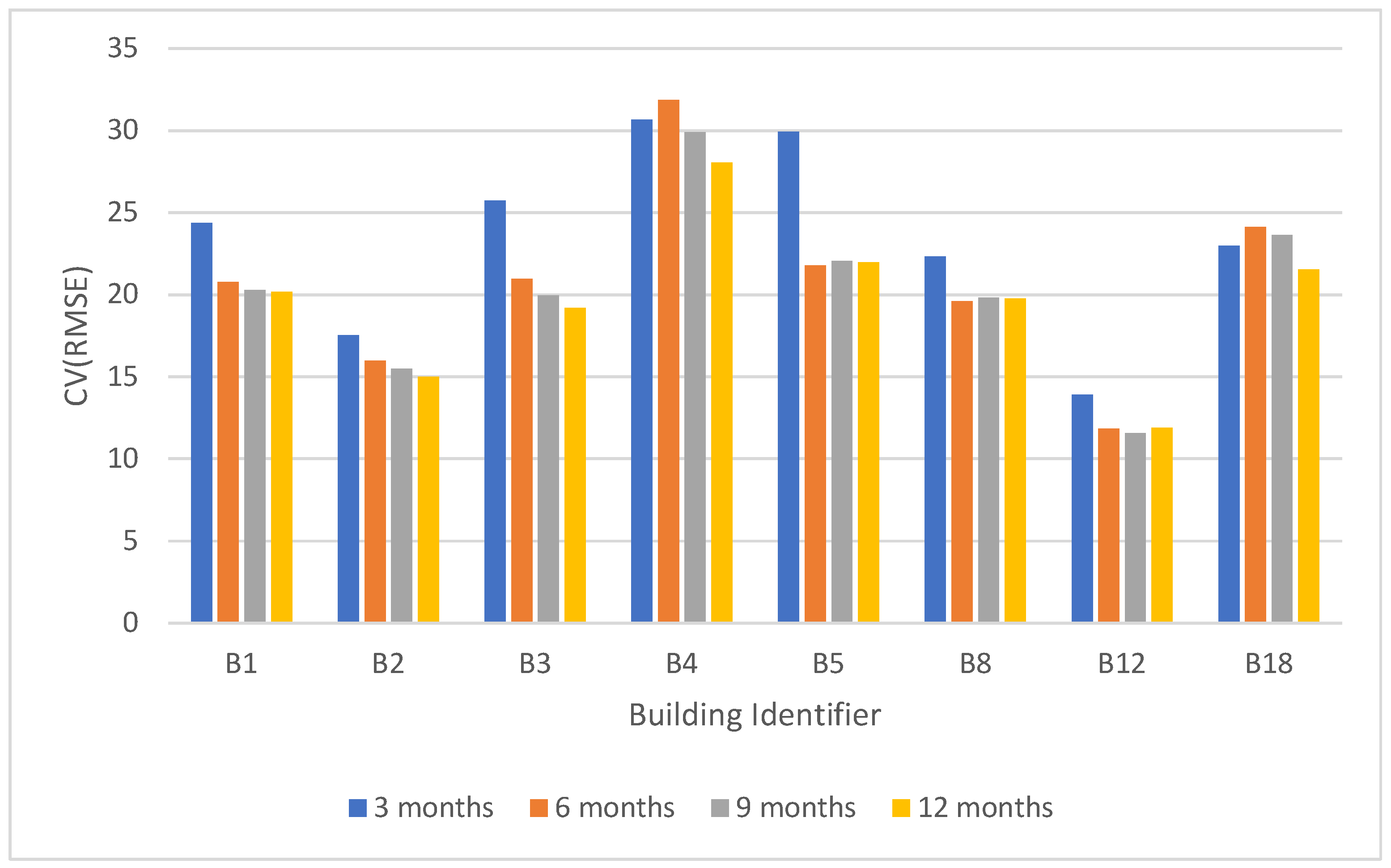
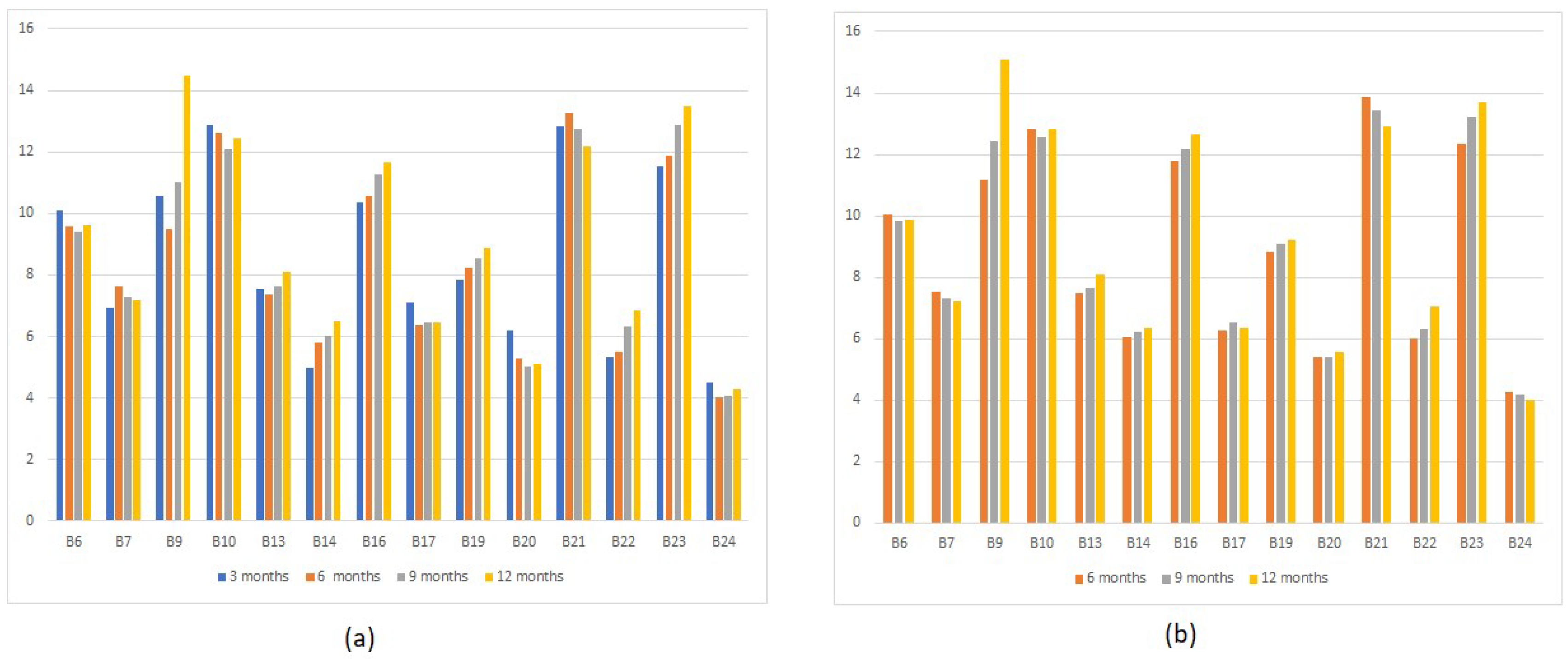
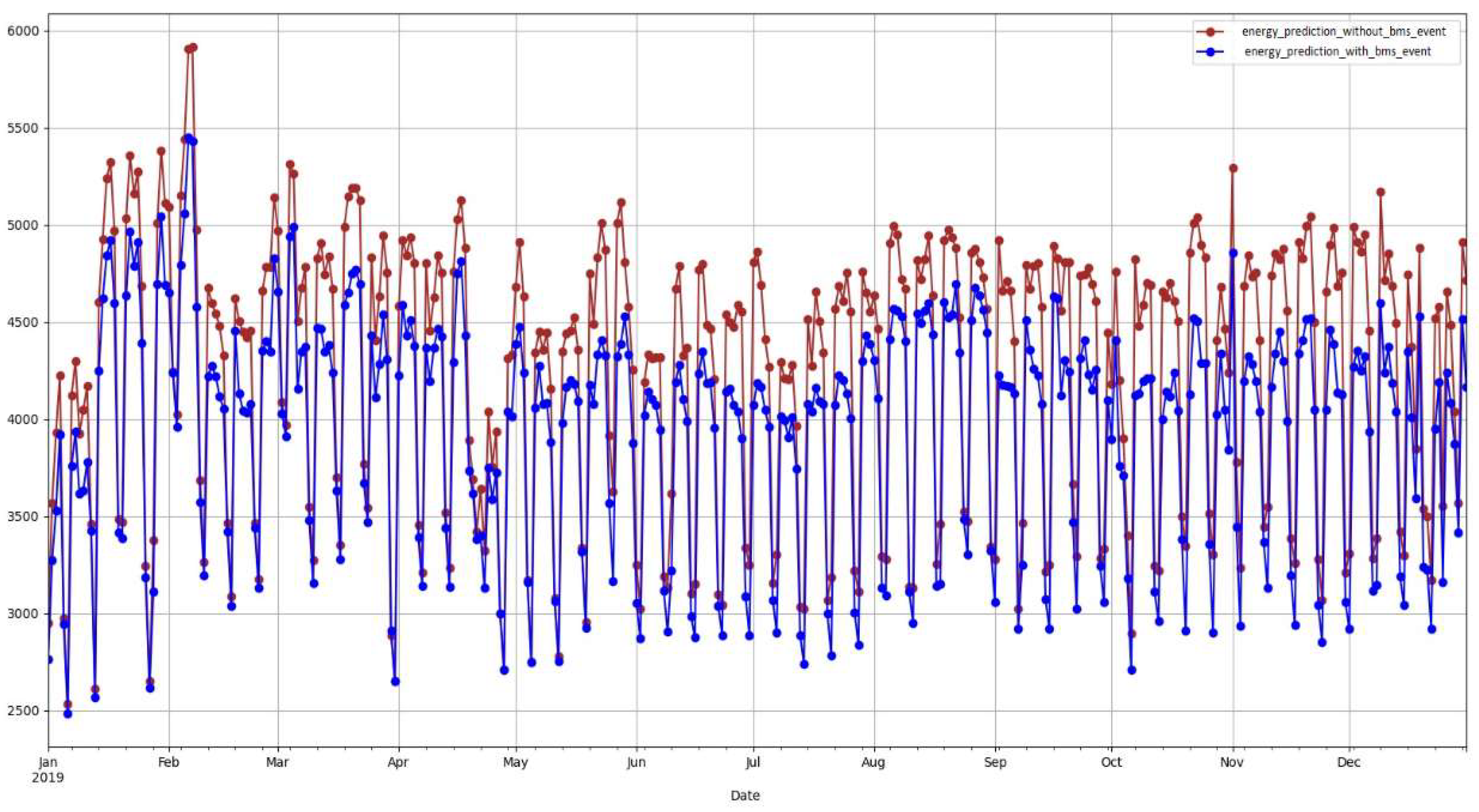
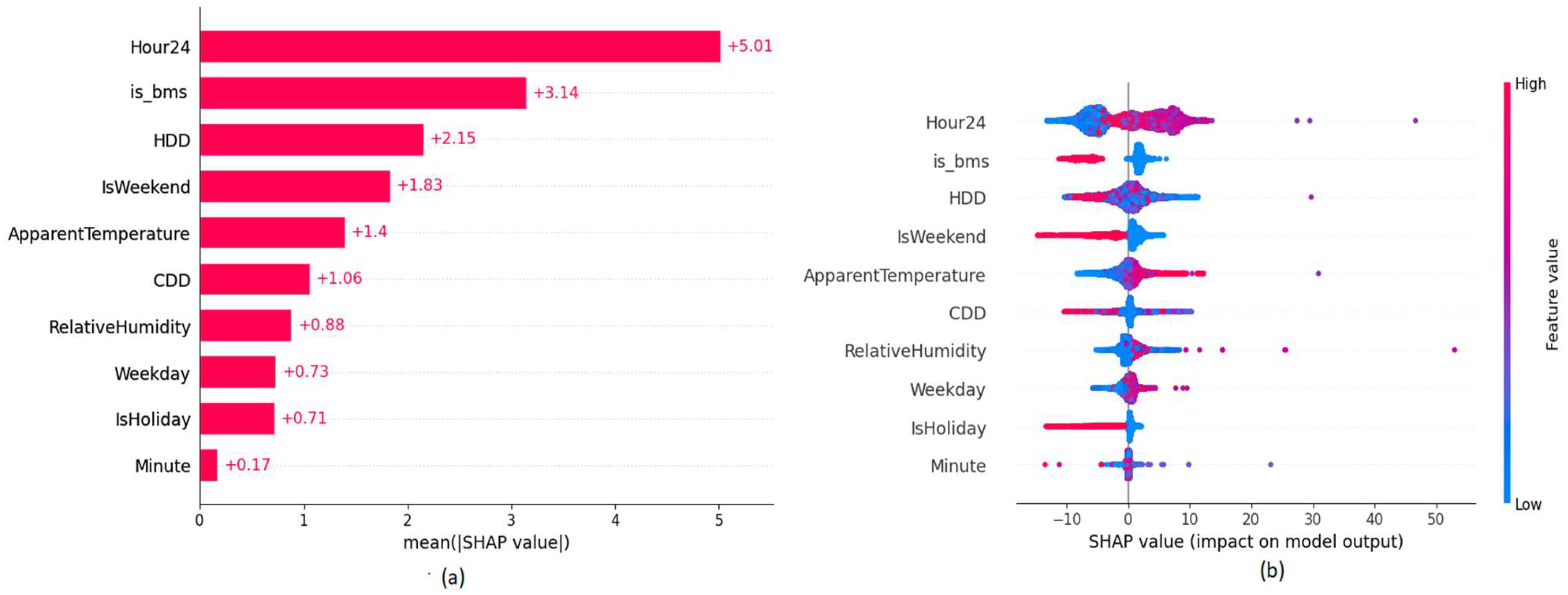

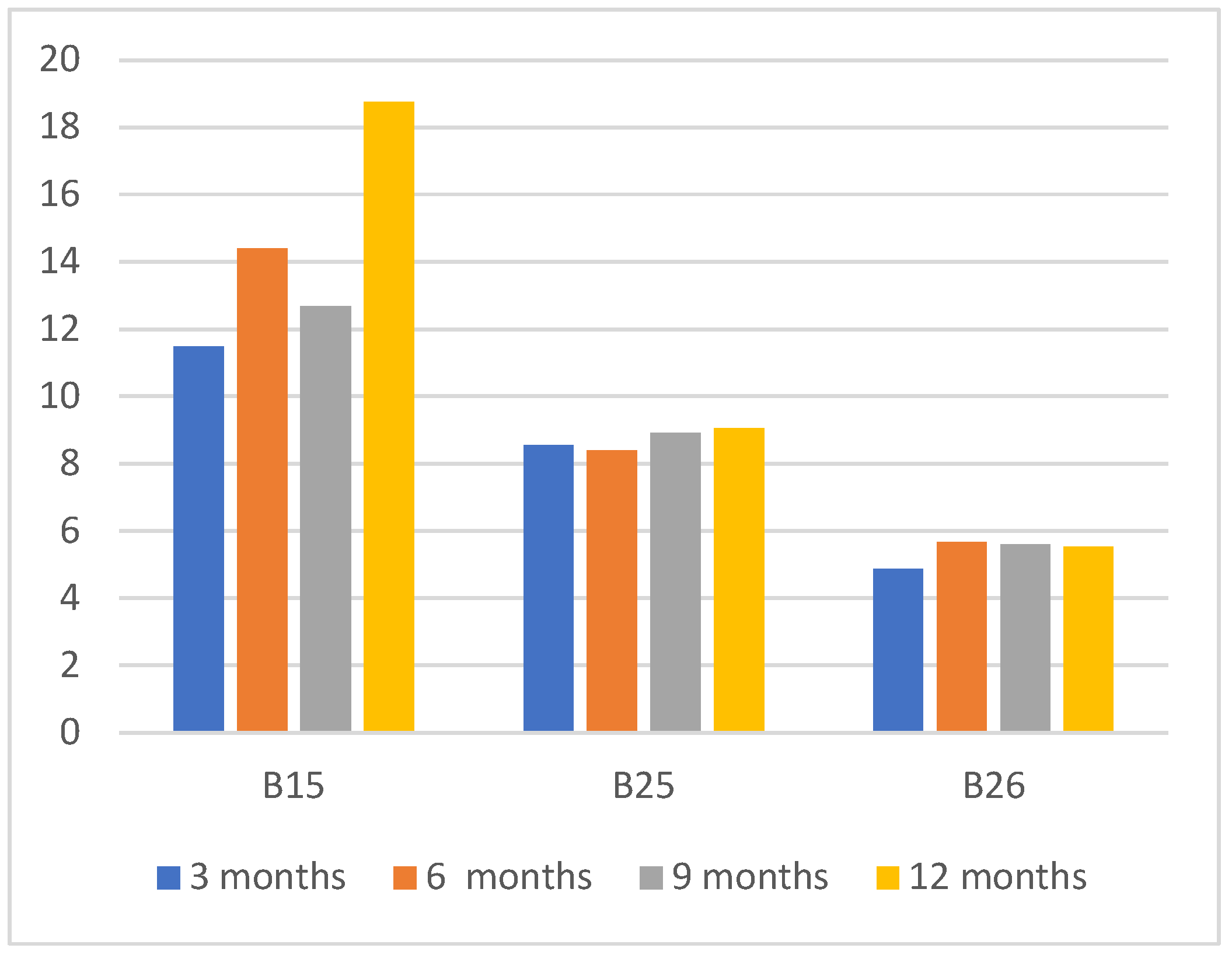
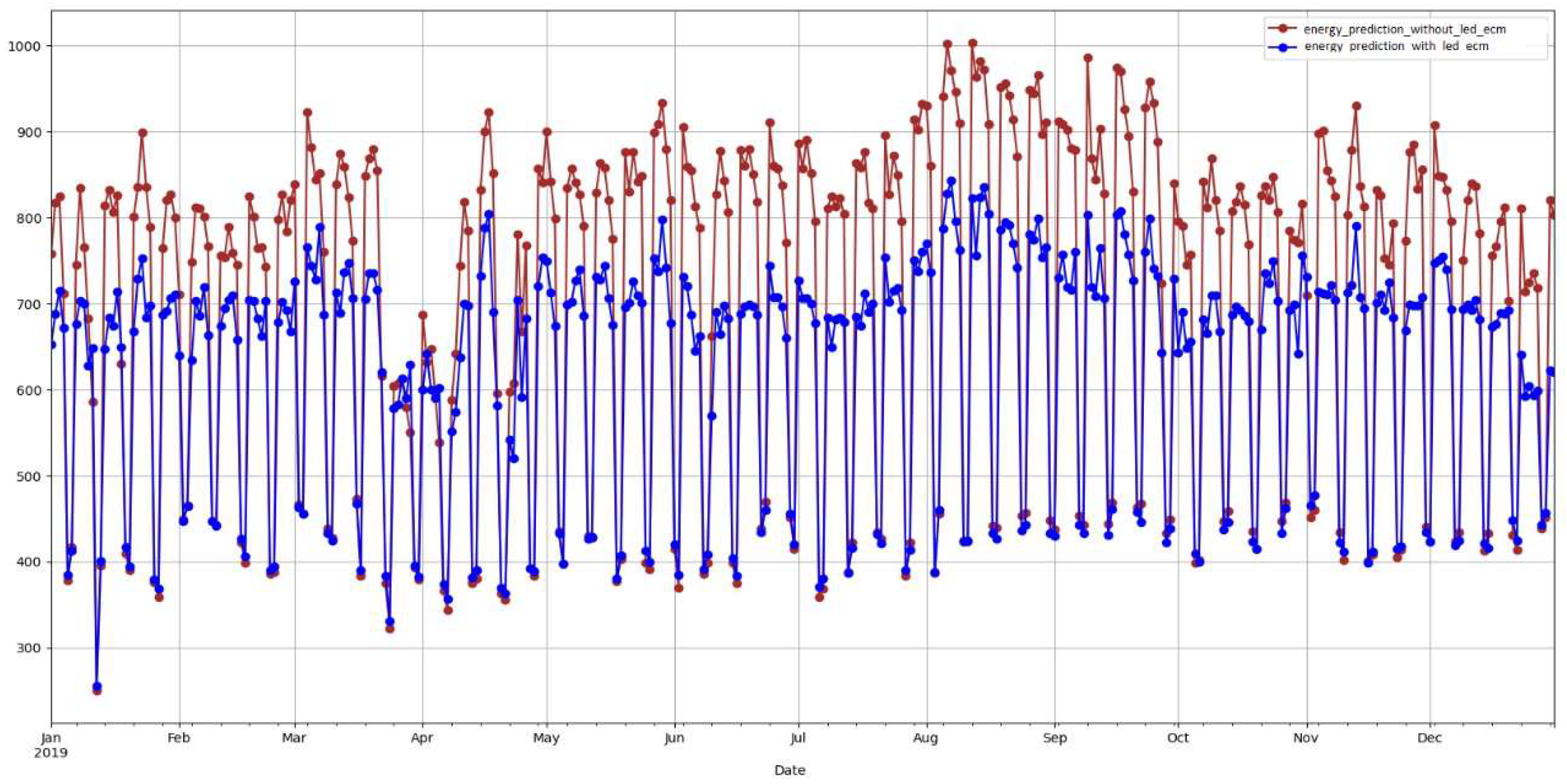
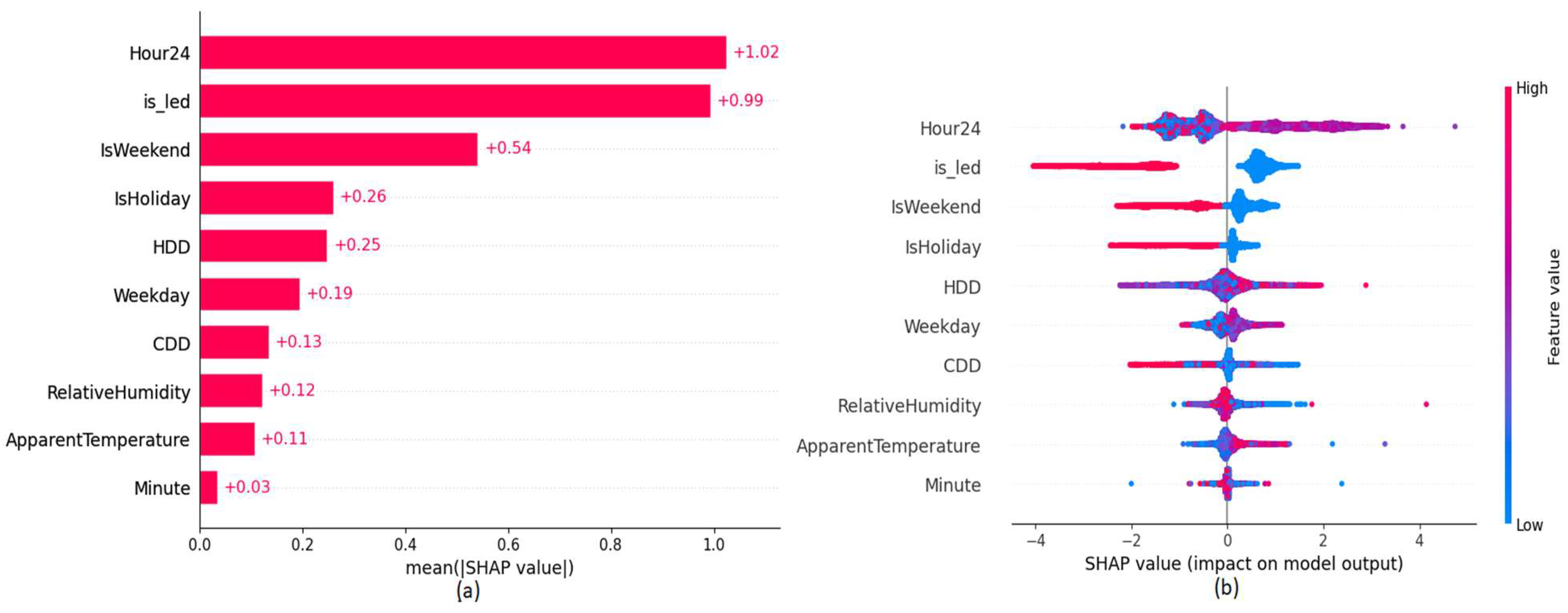


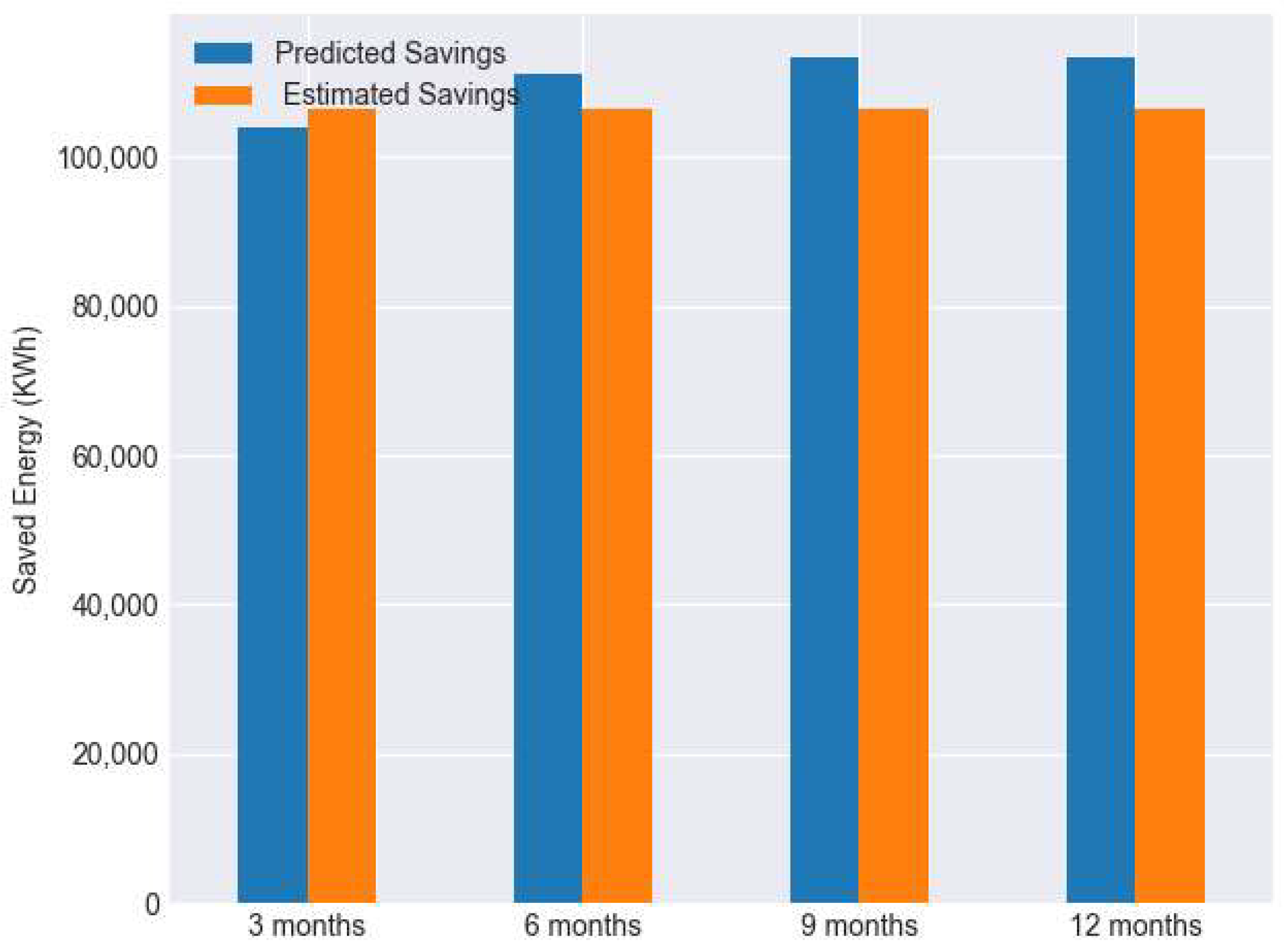

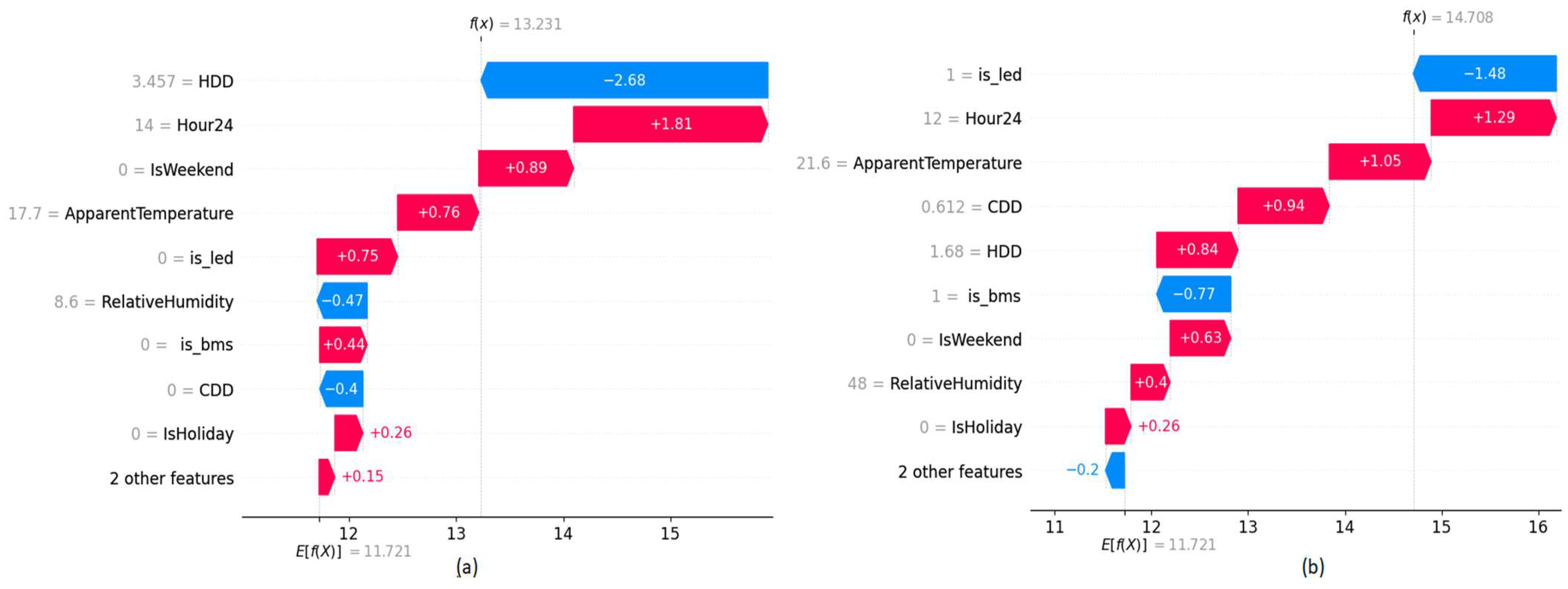
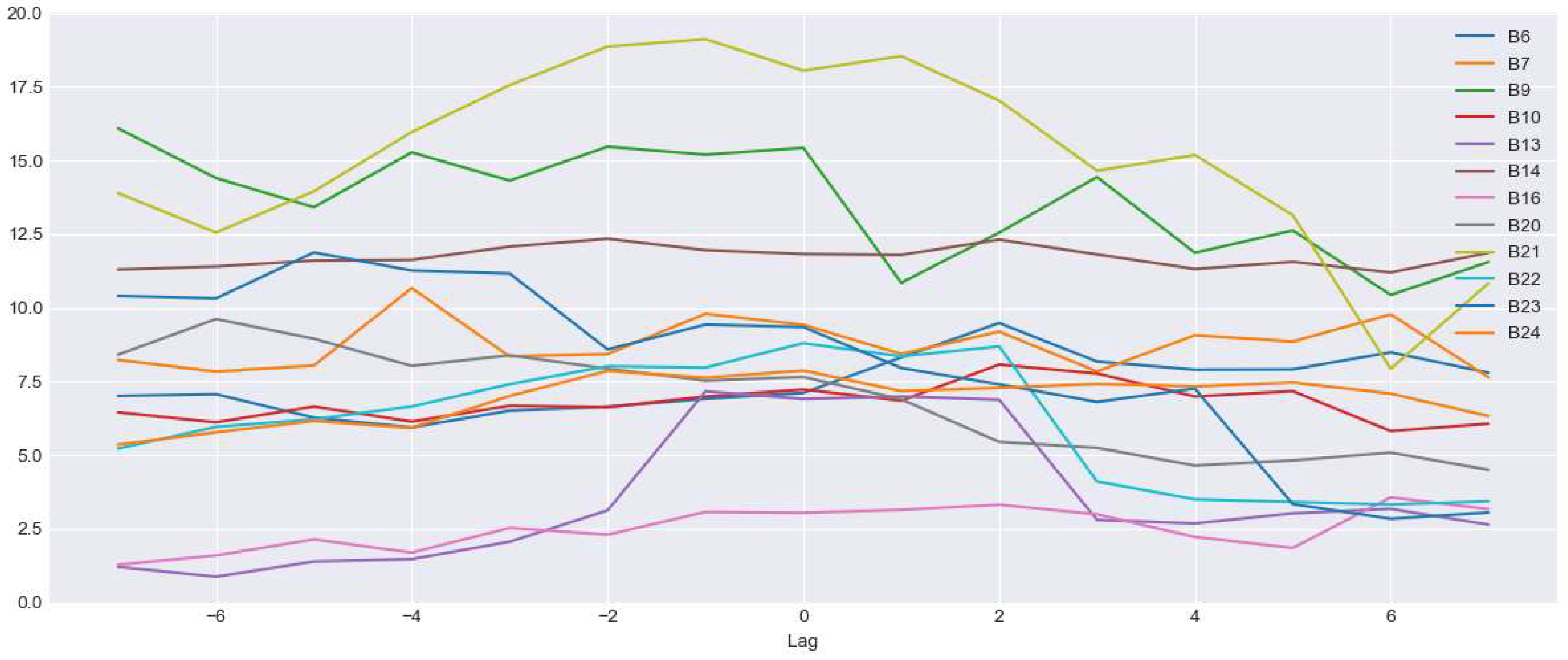
| Feature | Description |
|---|---|
| ApparentTemperature | Apparent temperature measured by the weather station |
| HDD | Heating Degree Days |
| CDD | Cooling Degree Days |
| RelativeHumidity | Relative humidity measured by the weather station |
| Weekday | Binary variable to indicate whether it is a weekday |
| Hour24 | Hour of the day |
| Minute | Minute of the day |
| IsHoliday | Binary variable to indicate whether the day is a holiday or not |
| IsWeekend | Binary variable to indicate whether it is a weekend or not |
| Building Ids | Date | |
|---|---|---|
| No-CEM | B1, B2, B3, B4, B5 | |
| BMS Upgrade | B6 | 23 April 2019 |
| B7 | 10 May 2019 | |
| B8 | 15 May 2019 | |
| B9, B10, B11, B12, B13, B14 | 17 May 2019 | |
| B15, B16, B17, B18, B19 | 23 May 2019 | |
| B20 | 29 May 2019 | |
| B21 | 30 May 2019 | |
| B22 | 2 June 2019 | |
| B23 | 7 June 2019 | |
| B24 | 15 June 2019 | |
| LED Installation | B13 | 21 October 2019 |
| B25 | 30 October 2019 | |
| B15 | 25 November 2019 | |
| B16 | 23 December 2019 | |
| B9, B26 | 9 December 2019 |
| Building | 3 Months (Post) | 6 Months (Post) | 12 Months (Post) | |||||||
|---|---|---|---|---|---|---|---|---|---|---|
| 3 mths | 6 mths | 9 mths | 12 mths | 3 mths | 6 mths | 9 mths | 12 mths | 3 mths | 6 mths | |
| B9 | 6.66 | 11.43 | 15.43 | 13.5 | 3.33 | 5.62 | 6.18 | 5.75 | 26.41 | 22.39 |
| B6 | 7.23 | 6.07 | 5.94 | 6.36 | 8.52 | 8.98 | 6.88 | 7.11 | 18.67 | 21.46 |
| B7 | 8.05 | 9.26 | 9.42 | 6.89 | 4.48 | 4.09 | 3.26 | 3.44 | −0.69 | −4.29 |
| B10 | 7.38 | 6.38 | 6.67 | 5.6 | 15.95 | 13.22 | 12.44 | 12.67 | 8.75 | 15.59 |
| B13 | 5.47 | 7.56 | 6.9 | 5.98 | 3.73 | 0.72 | 0.48 | 1.87 | 13.85 | 9.92 |
| B14 | 11.75 | 12.89 | 11.82 | 11.62 | 11.58 | 13.49 | 12.3 | 11.6 | 13.78 | 15.57 |
| B16 | 9.25 | 4.12 | 2.28 | 3.49 | 8.38 | 2.71 | 0.72 | 0.43 | 0.65 | 3.75 |
| B17 | 1.87 | 0.8 | 0.36 | 0.82 | 0.75 | −0.22 | −0.26 | −0.29 | 2.23 | 1.75 |
| B20 | 5.85 | 6.14 | 7.65 | 8.46 | 1.48 | 1.43 | 2.23 | 2.04 | 9.56 | 4.22 |
| B21 | 15.67 | 19.01 | 18.05 | 23.04 | 18.06 | 16.81 | 16.03 | 16.23 | 29.84 | 27.28 |
| B22 | 9.71 | 8.59 | 8.8 | 7.79 | 2.45 | 1.34 | 1.85 | 1.41 | 8.92 | 3.41 |
| B23 | 12.57 | 11.2 | 9.34 | 7.72 | 9.87 | 7.05 | 6.24 | 6.66 | 15.85 | 12.33 |
| B24 | 7.07 | 6.71 | 7.87 | 6.82 | 4.99 | 4.98 | 5.4 | 4.66 | 11.7 | 9.06 |
| Mean | 8.35 | 8.47 | 8.50 | 8.31 | 7.20 | 6.17 | 5.67 | 5.66 | 12.27 | 10.96 |
| 3 Months (Post) | Standard | ||||
|---|---|---|---|---|---|
| Model | 3 Mths | 6 Mths | 9 Mths | 12 Mths | 3 Mths |
| B26 | 24.93103 | 26.19834 | 27.32977 | 27.96718 | 26.53 |
| B15 | 9.4123 | 9.99353 | 10.05227 | 9.29150 | 10.49 |
| B25 | 13.63631 | 13.9096 | 12.08431 | 10.82881 | 11.53 |
| Building | BMS Upgrade | LED Installation | ||||||
|---|---|---|---|---|---|---|---|---|
| −3 m/3 m | −6 m/3 m | −9 m/3 m | −12 m/3 m | −3 m/3 m | −6 m/3 m | −9 m/3 m | −12 m/3 m | |
| B9 | 4.77 | 6.60 | 8.04 | 7.78 | 18.06 | 15.61 | 15.54 | 14.97 |
| B16 | 10.26 | 6.42 | 3.72 | 3.81 | 25.11 | 26.81 | 27.68 | 29.96 |
| B13 | 1.27 | 1.28 | 0.60 | 0.35 | 0.87 | 1.43 | 2.20 | 2.22 |
Publisher’s Note: MDPI stays neutral with regard to jurisdictional claims in published maps and institutional affiliations. |
© 2022 by the authors. Licensee MDPI, Basel, Switzerland. This article is an open access article distributed under the terms and conditions of the Creative Commons Attribution (CC BY) license (https://creativecommons.org/licenses/by/4.0/).
Share and Cite
Moraliyage, H.; Dahanayake, S.; De Silva, D.; Mills, N.; Rathnayaka, P.; Nguyen, S.; Alahakoon, D.; Jennings, A. A Robust Artificial Intelligence Approach with Explainability for Measurement and Verification of Energy Efficient Infrastructure for Net Zero Carbon Emissions. Sensors 2022, 22, 9503. https://doi.org/10.3390/s22239503
Moraliyage H, Dahanayake S, De Silva D, Mills N, Rathnayaka P, Nguyen S, Alahakoon D, Jennings A. A Robust Artificial Intelligence Approach with Explainability for Measurement and Verification of Energy Efficient Infrastructure for Net Zero Carbon Emissions. Sensors. 2022; 22(23):9503. https://doi.org/10.3390/s22239503
Chicago/Turabian StyleMoraliyage, Harsha, Sanoshi Dahanayake, Daswin De Silva, Nishan Mills, Prabod Rathnayaka, Su Nguyen, Damminda Alahakoon, and Andrew Jennings. 2022. "A Robust Artificial Intelligence Approach with Explainability for Measurement and Verification of Energy Efficient Infrastructure for Net Zero Carbon Emissions" Sensors 22, no. 23: 9503. https://doi.org/10.3390/s22239503
APA StyleMoraliyage, H., Dahanayake, S., De Silva, D., Mills, N., Rathnayaka, P., Nguyen, S., Alahakoon, D., & Jennings, A. (2022). A Robust Artificial Intelligence Approach with Explainability for Measurement and Verification of Energy Efficient Infrastructure for Net Zero Carbon Emissions. Sensors, 22(23), 9503. https://doi.org/10.3390/s22239503







